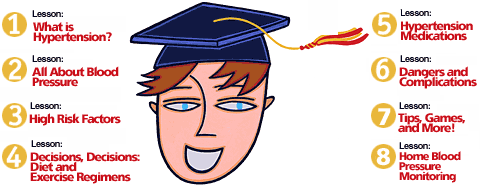



 |
|
|

|
|
Hypertension Lesson 8 - Home Blood Pressure Monitoring 
Back to Hypertension Channel
Decisions, decisions . . . although you only have one heart, there are no less than four types of blood pressure monitors out on the market. Although performing similar tasks (namely, the monitoring of both diastolic and systolic blood pressure readings), each apparatus is unique in certain specifications and features.
If we were comparing monitors to cars, the aneroid model would be a five-speed manual transmission. This device, not unlike the ones used by most physicians in their offices, involves an arm cuff attached to a round dial gauge with a needle that points to the correct blood pressure reading. Using a bulb pump, the user manually inflates the arm cuff, and using an attached stethoscope, listens to identify the blood pressure readings. Needless to say, using this monitor requires exceptional hearing and hand dexterity. In addition, knowledge of how tight to secure the cuff, and when and how to read the dial are also required. Experts recommend that this monitor be re-calibrated or adjusted by a professional at least once a year.
Ah yes . . .the automatic transmission. This is the life . . . Unlike the aneroid monitor, the digital monitor is automatic, and thus, is the most popular monitor available. The cuff is usually inflated at the push of a button (although some models still use hand-held pumping bulbs), and blood pressure readings appear digitally on a small electronic display screen. No additional stethoscope or attention is required. Simply secure the cuff, relax, and in a few minutes, a reading appears on the screen. Quick and reasonably painless . . . However, you should be aware that digital monitor readings are very sensitive to changes in body movement or heartbeat. Thus, they are not as accurate as the aneroid monitor. Also, many of these devices are designed to be used on a specific arm only (usually the right, which tends to be a bit longer than the left), and using the cuff on the wrong arm could vary the results by as much as 10-20 mm Hg. And to make matters even more difficult, the digital monitor requires . . . gulp . . . batteries. Again, the machine should be re-calibrated or adjusted about once a year.
This non-portable monitor, which looks like a large thermometer, is probably the most accurate of all available monitors, and, for a long time, was considered the "gold standard" that was used by physicians and hospitals that didn't need their machines to be portable. However, due to environmental and health concerns about leaking mercury, these monitors have been discontinued by many health care providers, who recommend aneroid or digital monitors instead.
This monitor is quite inexpensive and easy to use. It measures blood pressure using a cuff placed on your finger (or wrist) rather than your arm. However, since the finger or wrist is farther away from the heart than the arm, this device can produce the least accurate (and highly variable) readings of any monitor. In addition, position and body temperature also can throw off the readings, making it extremely difficult to accurately measure blood pressure levels. Many physicians and consumer rights groups have deemed this monitor unacceptable, and recommend choosing a different type of monitor. Page 1 2 3 4 5 6 Copyright © 2000-2025 savvyHEALTH.com. All rights reserved.
|
|
|
|||||||||||||||||
|
About savvyHEALTH | Privacy | Feedback | Home
http://www.savvyHEALTH.com/
All contents copyright © 1999-2025 savvyHEALTH, Inc. All rights reserved.
This internet site provides information of a general nature and is
designed for educational purposes only. If you have any concerns about
your own health, you should always consult
with a physician or other healthcare professional. Please review the Terms of Use before using this site. Your use of the site indicates your agreement to be bound by the Terms of Use.
|
|